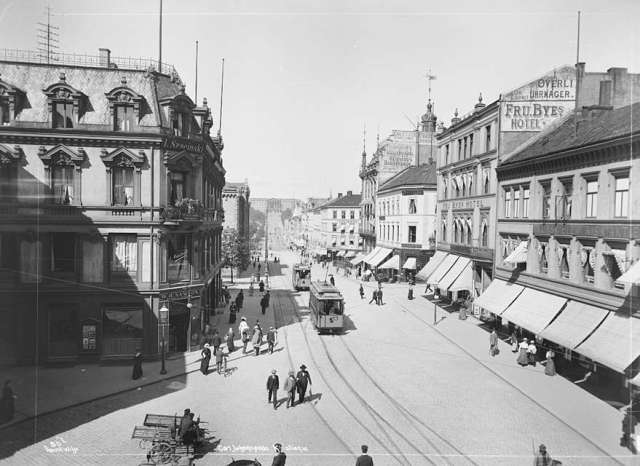Karl Johans gate on:
[Wikipedia]
[Google]
[Amazon]
Karl Johans gate is the main street of the city of Oslo, Norway. The street was named in honor of King Charles III John, who was also King of Sweden as Charles XIV John.
Karl Johans gate is a composite of several older streets that used to be separate thoroughfares. The eastern section was part of Christian IV's original city near the ramparts surrounding the city. When the ramparts were removed to make way for Oslo Cathedral, three separate sections eventually became ''Østre Gade''.
The wider western section was built during the 1840s as an avenue connecting the newly erected Norwegian Royal Palace with the rest of the city. In 1852, it was named Karl Johans gate in honor of the recently deceased king. His equestrian statue, by sculptor ''Karl Johans gate'' (Store norske leksikon)
/ref> In its current route, it connects
In its current route, it connects
File:Spikersuppa.jpg, Eidsvolls plass
File:Scating in Spikersuppa Oslo.jpg, Spikersuppa
File:Oslo-karljohan.jpg, Karl Johans gate
in spring ( Norwegian Constitution Day, 17 May) File:Oslo seen from the Castle 2.jpg, Karl Johans gate
in winter File:Fountain Karl Johans Gate Oslo.jpg, A fountain next to Karl Johans Gate in early summer
Brynjulf Bergslien
Brynjulf Larsen Bergslien (12 November 1830 – 19 September 1898) was a noted Norwegian sculptor.
Background
Bergslien was born in Voss in Hordaland county, Norway. He was a son of Lars Bergeson Bergslien and Kirsten Knutsdotter Gjelle. He was ...
, was later erected during 1875 in front of the Royal Palace. When the Norwegian parliament building was completed in 1866 at the junction of the two formerly separate streets, the two streets were joined and the whole length was named Karl Johans gate./ref>
 In its current route, it connects
In its current route, it connects Oslo Central Station
Oslo Central Station ( no, Oslo sentralstasjon, abbreviated ) is the main railway station in Oslo, and the largest railway station within the entire Norwegian railway system. It connects with Jernbanetorget station. It's the terminus of Dramme ...
, the main railroad station in Oslo, and the Royal Palace
This is a list of royal palaces, sorted by continent.
Africa
* Abdin Palace, Cairo
* Al-Gawhara Palace, Cairo
* Koubbeh Palace, Cairo
* Tahra Palace, Cairo
* Menelik Palace
* Jubilee Palace
* Guenete Leul Palace
* Imperial Palace- Massa ...
. The route changes its direction and width slightly halfway between these two points, at Egertorget
Egertorget is a pedestrian mall located at the intersection of Karl Johans gate and Øvre Slottsgate in Oslo, Norway.
History
Egertorget is a square which arose around 1840 where Karl Johans gate and Øvre slottsgate crossed each other along ...
, a square at the intersection of Karl Johans gate and Øvre Slottsgate. This is the highest point and, here, both ends of the street may be seen. The street is 1,020 metres long; in addition there are 300 metres of direct extensions, Palace Hill (''Slottsbakken'') and Palace Place (''Slottsplassen'').
The street includes many of Oslo's tourist attractions: In addition to the Royal Palace, Central Station and Stortinget
The Storting ( no, Stortinget ) (lit. the Great Thing) is the supreme legislature of Norway, established in 1814 by the Constitution of Norway. It is located in Oslo. The unicameral parliament has 169 members and is elected every four years base ...
, there are the National Theatre, the old University Buildings, the Palace Park and the pond (''"Spikersuppa"'') at Eidsvolls plass, which serves as a skating rink in winter. Oslo Cathedral's lower end is surrounded by the Bazaar Market (''Basarene ved Oslo domkirke''), which is integrated with the historic Fire Watch (''Brannvakta'') that served as Oslo's main fire station from 1860 until 1939.
in spring ( Norwegian Constitution Day, 17 May) File:Oslo seen from the Castle 2.jpg, Karl Johans gate
in winter File:Fountain Karl Johans Gate Oslo.jpg, A fountain next to Karl Johans Gate in early summer
See also
* Oslo Astrological Clock * Sentrum, OsloReferences
Streets in Oslo Charles XIV John {{Norway-road-stub